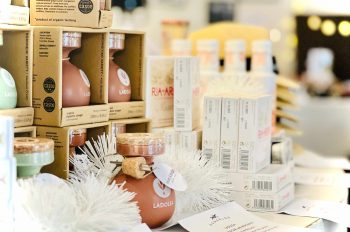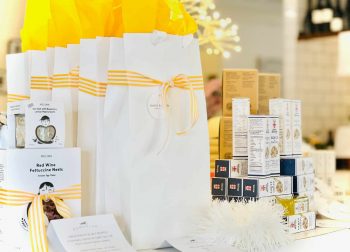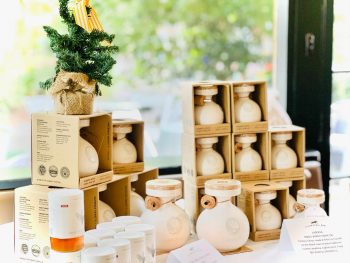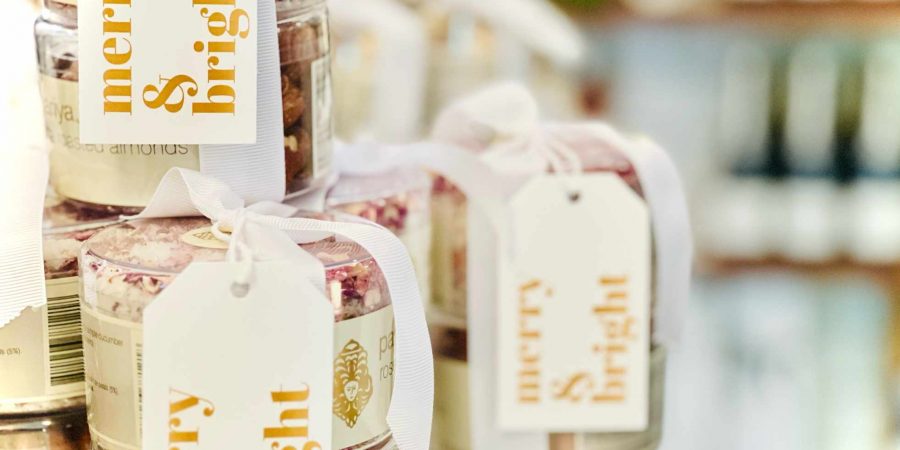We officially kicked off the festive season last weekend at our annual Champagne Shopping Morning.
It was such a lovely day! A big thanks to everyone who came along and made it such a special day for us.
Lucy has outdone herself this year and procured the most fabulous goodies for you to fill your Christmas hampers and stockings with.
Here, have a look for yourself…








So, in the spirit of the festive season, let’s continue the theme as we delve back into the wonderful world of Australian Sparkling wine…
HOW TO MAKE SPARKLING WINE
The process
Making sparkling wine is more complex and time-consuming than still winemaking.
Sparkling winemaking begins with the careful and selective harvesting of grapes. For high quality sparkling wine, winemakers look for premium grapes with high natural acidity. Sparkling wine grapes are also generally harvested earlier to ensure they have low sugar levels of approximately 9–11° Baumé.
Sparkling winemakers then press whole bunches of grapes gently to avoid extracting any colour or undesirable phenolics, such as tannins, from the red varieties.
The must (or pressed grape juice) then undergoes regular alcoholic fermentation to produce a base wine that is high in acidity and has a very neutral fruit flavour. Techniques such as malolactic fermentation and barrel fermentation are sometimes used, depending on the style of base wine desired (Rob uses both of these).
Winemakers then produce a cuvée, or base wine, by blending different batches of wine. A cuvée often comes from more than one grape variety.
Putting the bubbles in the bubbles
And then it’s time for the bubbles.
I’ve written a pretty detailed post on this in the past, so you can have a look at that over here.
But in short, there are four methods for getting bubbles into the base wine. We use the most difficult and time consuming one – the traditional French method.
Grape varieties
A number of grape varieties go into making Australian sparkling wines. Chardonnay, Pinot Noir and Pinot Meunier are the most common grapes. Other grapes include Semillon, Chenin Blanc, Riesling, Crouchen, Trebbiano and Muscat Gordo Blanco.
Red grapes, such as Shiraz, Merlot and Cabernet, usually go into medium to full-bodied sparkling reds.
Vintage and non-vintage
Sparkling wines are either vintage or nonvintage (NV).
The vintage is the year the winemaker harvests the grapes. Vintage wines are those produced from grapes from an excellent single-vintage harvest. For these wines, the year typically appears on the wine’s label.
NV wines comprise blends from different years (usually from two or three vintages) – this is to promote a consistency of style and quality in the sparkling wine from year to year.
Loving our blog? Sign up for weekly updates straight to your inbox…
[withwine type=’join-mailing-list’]
AUSTRALIAN SPARKLING WINE STYLES
Most Australian sparkling wine consists of Chardonnay and Pinot Noir grapes, with the most common style a blend of the two. Australian grape growers pick cool-climate Chardonnay fruit early to retain its high acidity levels before it’s too ripe and acidity levels decrease.
Some winemakers also make single-variety (100%) sparkling Chardonnays, known as Blanc de Blancs (French for ‘white of
whites’). Australian Blanc de Blancs tend to be elegant, savoury, floral and dry, with robust acid. Aged Blanc de Blancs – like all sparkling wines that have spent extended time on lees – can also develop toasty notes.
Other winemakers (like Rob!) do produce single-variety (100%) sparkling Pinot Noirs, known as Blanc de Noirs (French for ‘white of blacks’, or white wine made from red grapes).
In addition to Pinot Noir, Australian winemakers blend Chardonnay with Pinot Meunier; sparkling wine blends that include red varieties such as Pinot Noir or Pinot Meunier tend to be more full-bodied and show more delicate red fruit notes than those made from just Chardonnay.
Dry brut style
A dry brut is the standard style for most sparkling wines. Brut indicates that the wine has a specific range of dosage resulting
in no more than 12 g/L of residual sugar. Typical aromas for Australian dry brut styles are biscuit, dough, toast, apple and grapefruit.
Sparkling rosé
Australian sparkling rosé makers typically make their wines primarily from Pinot Noir (and sometimes other red) grapes. They produce sparkling rosé in the same way they produce white sparkling, but they achieve the range of rosé colours in a few different ways:
- By blending a small percentage of red wine (usually Pinot Noir or Pinot Meunier) with the cuvée. This process is known as rose d’assemblage and is the most common method.
- By allowing for limited skin contact with red grapes during primary fermentation. This is known as the saignée method (French for ‘bleed’) in French sparkling wine production.
Australian sparkling rosés typically range in colour from salmon to pink and display characteristics similar to those of light red wines. Their aromas include floral, rose petal, strawberry, raspberry and red currant, and more complex wines may also feature spicy or nutty notes.
Other sparkling wine terms and variations
If you see one of the following terms on an Australian sparkling wine label, here’s what it means:
- Crémant: A term sometimes used in Australia to indicate a sparkling wine with less effervescence due to less pressure in the bottle.
- Frizzante: Slightly sparkling.
- Moscato: Lightly sparkling wines typically with low alcohol but high sugar levels. Must be made from at least 85% of varieties within the Muscat family.
- Prosecco: A fresh, crisp white sparkling wine that is seeing great success in Australia.
I could go on, but again… let’s come back to this another day.
In the meantime, make sure you have a look on our website for all our lovely Christmas produce ready to send as gifts to your family and friends.
… or yourself!
